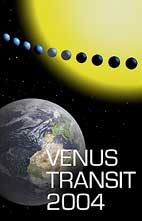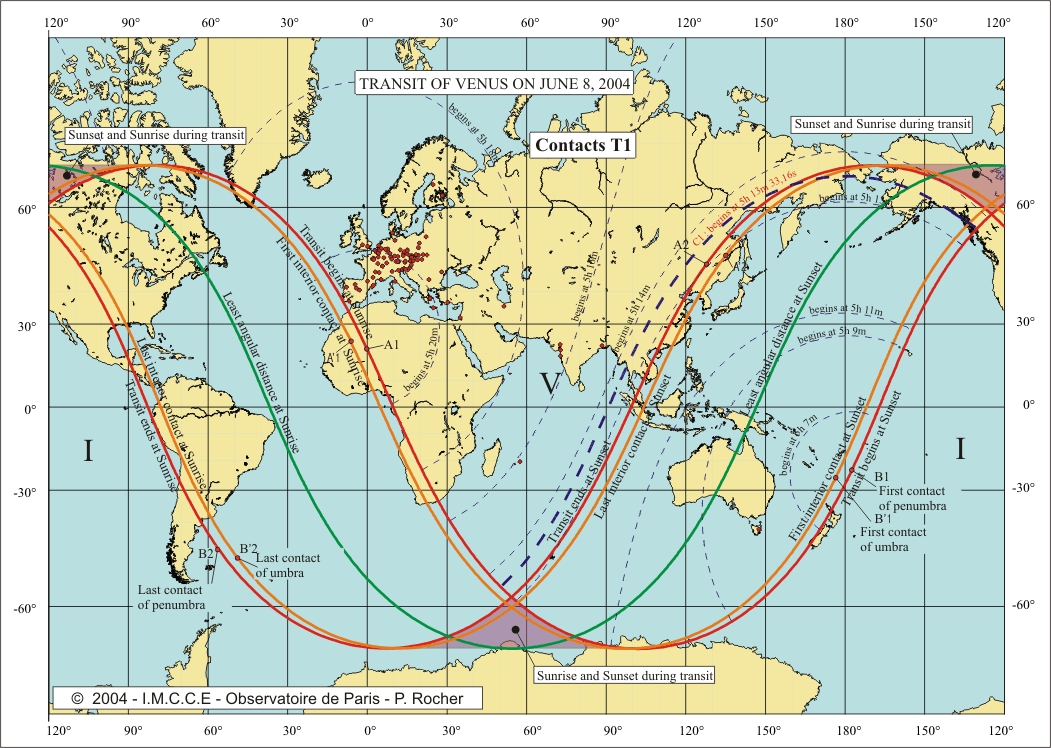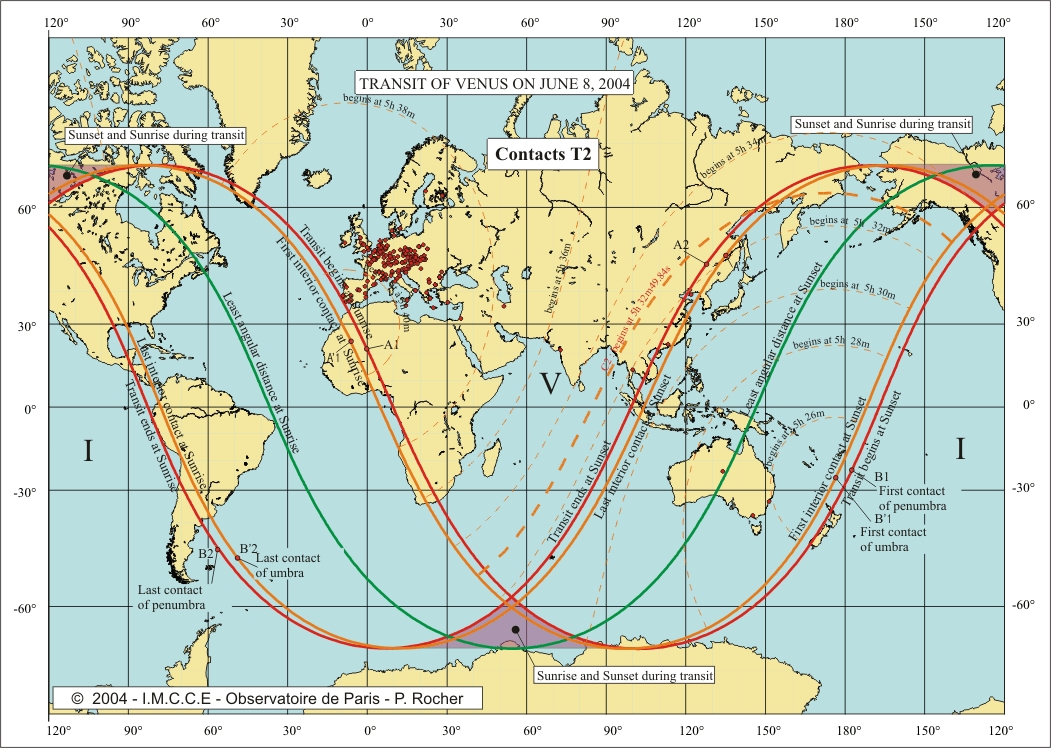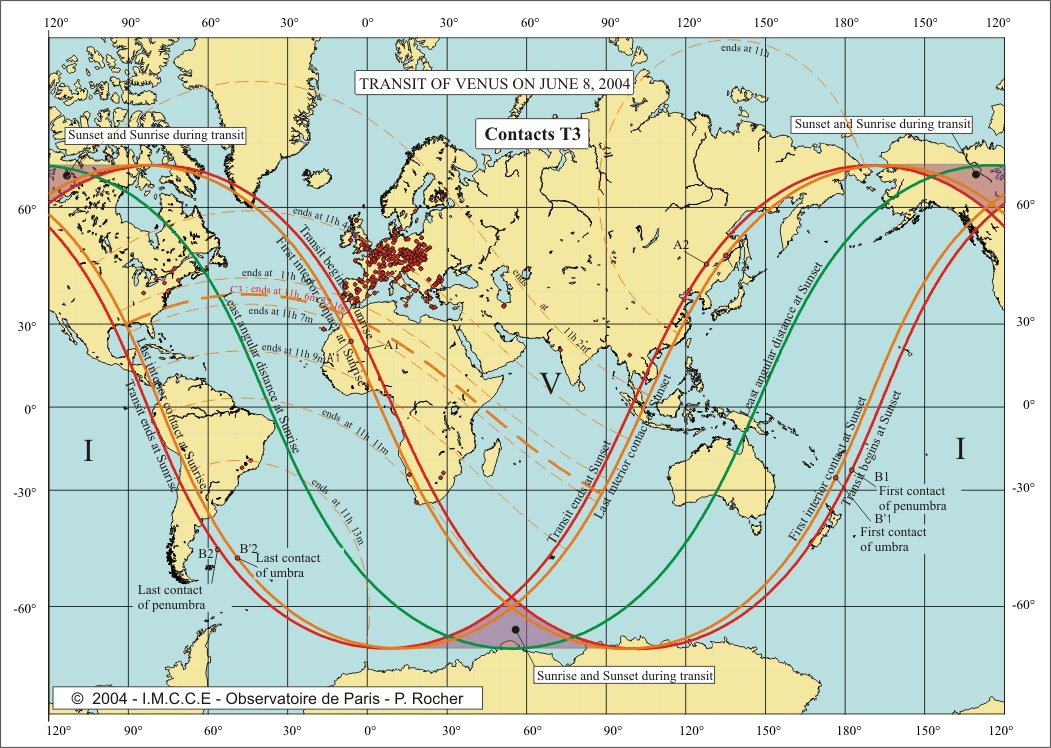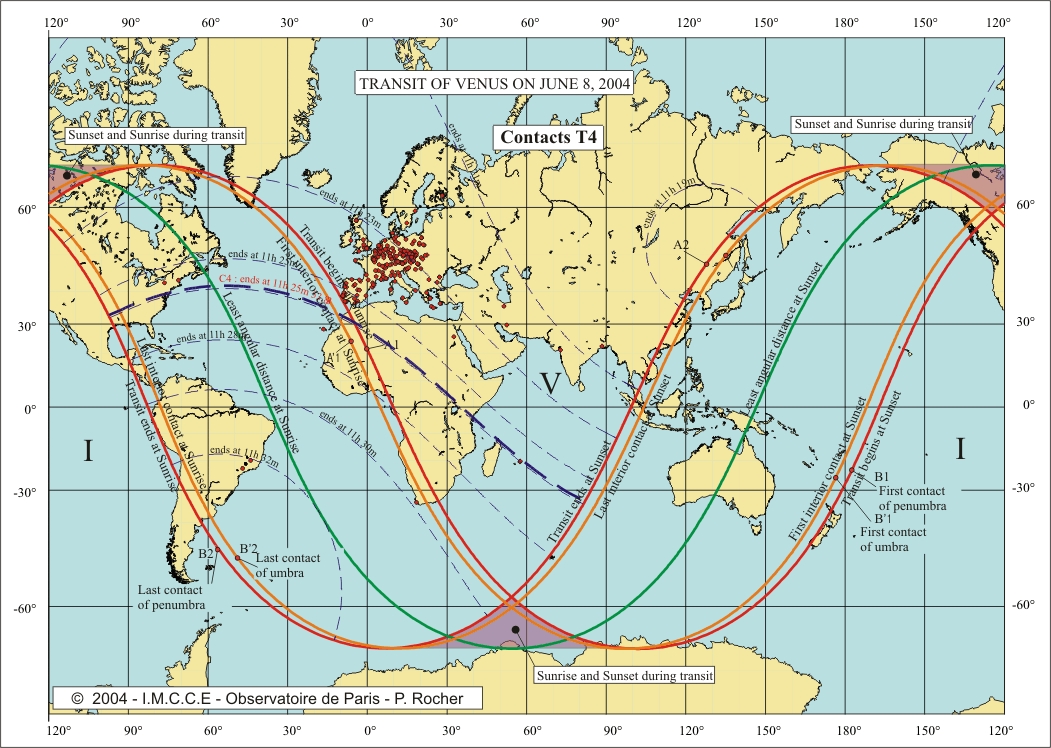Information note n°31b
Analysis of the observations of contacts
Calculation of the AU using the whole set of data :
P. Rocher, J.-E. Arlot,
Introduction.
We are now
after June 8 and we have received all the observations of contacts. We may
calculate the AU using a not constrained system or using the Delisle’s method
using only some selected observations. For that purpose, we must find a
criterion to select the “good” observations of contacts. In a first step we
will suppose that the « good » observations are the ones near the
predictions that we made. We will verify afterwards that this hypothesis is
justified.
Then, we
will select several sets of observations and we will calculate the AU using the
not constrained method. We will also made the calculation after weighting the
observations depending on the site of observation that should lead to a more
realistic value of the AU. At last we will apply the Delisle’s method on our
best set of data in order to see if it is applicable even if the observers were
not organized as during the past centuries.
The calculation of the AU
with the whole database of contacts
First, we
have to be sure that the theoretical value of the parallax (or the AU) entered
in the calculation of prediction of the contacts is good, compared to the
experience that we are performing (i.e. the observation of the contacts for the
determination of the AU).
How to do that ?
If this
theoretical value is good, the average of the AU that we are calculating thanks
toi the observations of contacts must converge as we decrease the interval of
time around the predicted value in which we keep the sample of observations
that we keep.
More
explanations: we select all the observations being made at most at 30 seconds
of time, for example, from the prediction and we make the average of the AU
calculated with these observation. Then, we decrease the interval (15s, 8s, 4s)
and we make the average of the calculated AU for each sample corresponding to
each interval. If our initial theoretical value of the AU used for the
prediction is good, the succession of averages converges towards our initial
value. At the same time, the number of observed contacts late referred to the
prediction will approach the number of contacts in advance and the average
of these variations will tend towards zero insofar as the distribution of
errors is Gaussian. This
will be shown by the analysis of the data that we received.
Below, the results obtained with the whole data base as it was on July 14, 2004.
Characteristics of the
data base :
Number of
registered observers having sent observations : 1501.
Number of
registered observers having observed the first contact : 722.
Number of
registered observers having observed the second contact : 1139.
Number of
registered observers having observed the third contact :1336.
Number of registered observers having observed the
fourth contact :1170.
Number of
registered observers having measured the external duration : 639.
Number of
registered observers having measure the internal duration: 1014.
Number of
registered observers having measured the four contacts: 616.
Total number of observations : 4367.
In the
table below, we provide successively : the size of the interval 2DT around the predicted values of the contacts, the number of observations
corresponding to this criterion, the average of the calculated AU solving the
not constrained system with these observations, the shift to the real value of
the AU and the value of the corresponding parallax.
|
Size of the interval |
Number of observations |
Average of the calculated AU |
Shift
to the true AU |
Corresponding parallax |
|
60s |
2459 |
148511434 km |
1086436 km |
8,858482" |
|
30s |
1719 |
148789697 km |
808172 km |
8,841915" |
|
16s |
1066 |
149421803 km |
176067 km |
8,804510" |
|
8s |
583 |
149608708 km |
-10838 km |
8,793511" |
Table 1
This
analysis of the observations proves that the experiment confirms that the
initial value of the parallax (or AU) used for the predictions is correct and mainly,
this confirms the quality of the predictions made with this value. This result
comes from the fact that the data base contains many observations (1066) close
to the prediction (in the interval of 8s).
From now on, the definition of a “good” observation is an observation being close to the predictions since our predictions are close to the reality. We have now an objective criterion for the selection of observations in the data base.
This result has been obtained by analysis of observations from 1501 observers representing 4367 contacts. It was not possible to get such a result in real time on June 8 since we did not know in advance what will be the “good” observations and if the errors will follow a normal law (Gaussian distribution).
Results for an interval of
16s for each contact :
The
following tables provide successively for each contact and for all contacts
together the number of observations corresponding to the interval of 16s, the number
of observations in advance referred to the prediction and the number of observations
late, then the average of the calculated values of the AU using these
observations, the shift to the true value of the AU, the standard deviation and
the parallax corresponding to the calculated AU.
|
Contact |
Number of
observations |
Number
of observations in advance from Tc |
Number
of observations late from Tc |
Average AU in km |
Shift
to the true value in km |
Standard deviation in
km |
Parallax |
|
T1 |
104 |
49 |
55 |
149443844 |
154026 |
186773 |
8.803212" |
|
T2 |
262 |
128 |
134 |
149590268 |
7602 |
108359 |
8.794595" |
|
T3 |
421 |
187 |
234 |
149226725 |
371145 |
324822 |
8.816020" |
|
T4 |
279 |
130 |
149 |
149549752 |
48118 |
70599 |
8.796978" |
|
All |
1066 |
|
|
149421803 |
176067 |
252081 |
8.804510" |
Table 2.
So, using
all the observations within 8s to the prediction (interval of 16 sec), we get
the following result: AU = 149421803 km +/- 252081 km
For the
calculation of these values, we calculate the average ![]() of the
of the ![]() (the calculated AU for each
observation).
(the calculated AU for each
observation).
![]()
Then we
calculate the experimental variance ![]() and the
experimental standard deviation
and the
experimental standard deviation ![]() of these
measures of the AU.
of these
measures of the AU.

At last,
supposing that ![]() is a random
variable following a normal law (Gaussian distribution of the errors), i.e.
that the observations are without biases, then
is a random
variable following a normal law (Gaussian distribution of the errors), i.e.
that the observations are without biases, then ![]() is a good estimator of the AU
and the standard deviation
is a good estimator of the AU
and the standard deviation ![]() on this estimator is given by :
on this estimator is given by :
![]()
Be careful
to do not confuse the experimental standard deviation s on the measures which is independent of the law of distribution of
the observations and the standard deviation ![]() on the estimator which depends
on the law of distribution of the observations
on the estimator which depends
on the law of distribution of the observations
We may
remark that we have, as envisaged, a rather good distribution of the
observations before and after the predicted values. We may remark also that the value of the
calculated AU using the third contacts is the worst with the largest standard
deviation. This comes from observations mainly made when the Sun is near the
zenith for the observers (with a small diurnal parallax).
Tableau 3 is
identical to table 2, but for the observations corresponding to an interval of
8s.
|
Contact2Dt = 8s |
Number of obser-vations |
Number
of observations in advance on Tc |
Number
of observations late on Tc |
Average
of the AU in km |
Shift
to the true AU in km |
Standard
deviation of the AU in km |
Parallax in arcsec |
|
T1 |
60 |
23 |
37 |
149725155 |
-127285 |
131387 |
8.786672" |
|
T2 |
148 |
67 |
81 |
149618152 |
-20282 |
69271 |
8.792956" |
|
T3 |
225 |
102 |
123 |
149267460 |
330410 |
217813 |
8.813614" |
|
T4 |
150 |
76 |
74 |
150064685 |
-466815 |
55667 |
8.766792" |
|
All |
583 |
|
|
149608708 |
-10838 |
11835 |
8.793511" |
Table 3
So, using
all the observations within 4s to the prediction (interval of 8 sec), we get
the following result: AU = 149608708 km +/- 11835 km
We may
remark that for each contact taken separately, the results tend to
be degraded ; the
values of the AU obtained using the contacts T3 and T4 show
standard deviations smaller than the shift to the true value of the AU: the
distribution of the errors may not be Gaussian. Contrarily, the result using
all contacts is better.
Why the
results from the third contact are so bad ? Quite simply because
very many places of observations have a weak diurnal parallax at the time of
the third contact (Sun
too high above the horizon) and because they are too close to the intersection of
the shadow cone at the time of the third geocentric contact with the terrestrial
ellipsoid. One can visualize that on a map by plotting on the terrestrial sphere
the four curves intersections of the cones of shadow and penumbra with the
terrestrial ellipsoid at the moments of the geocentric contacts.
The closer
one group of observers is to one of these curves, the more the effects of the
diurnal parallax for the corresponding contact will be small and more the
dispersion of the measurements is likely to be large if it is not compensated
by very good measures of the contacts. Moreover the observation of the moments
of interior contacts T3 is a little more difficult than that of the external
contacts T4 because of the black drop. Thus the contacts T3 and T4 should be
easier to observe than the contacts T1 and T2 since the majority of the
observers observed them high in the sky, but, although better
(225 observations retained here for T3 against 148 for T2) these observations
give worse results, precisely because the Sun is close to the zenith.
Weighted
average.
In the preceding calculation, we were satisfied to
make the average of all the calculated values of the astronomical unit and we
allotted the same weight to each result. However it is known that the errors of
observation, for a contact given, from a place badly located can generate important
variations in the results.
Thus a random error of a few seconds on the measurement of a contact can
have effects more or less strong on the value of the calculated AU.
We thus
will try to weight these results by giving a weight to each observation, this
weight will be all the more weak as the place is badly located for a contact
considered.
If it is
supposed that the observations are made without skew with a random error t. then the standard deviations on the parallax or the astronomical unit
can be estimated, for each observation, by :

where tc
is the instant of the topocentric contact calculated and tG is
the instant of the geocentric contact.
One can
take as weight of each observation : ![]()
Then the
weighted averages of the astronomical unit and the parallax are calculated
starting from the individual values a(k) ou p(k) calculated for each observation k using
the two folowing relationships :

and the
standard deviations on the weighted averages are given by :

Here results obtained on the sample
of the 1066 observations of the contacts included in the interval 16 seconds
around the predicted values and if it is supposed that the random error on each
observation is of +/- 5s. This table is to be compared with table 2.
|
Contact |
Number of
observations |
Weighted average AU
in km |
Shift
to the true AU in km |
Standard deviation in
km |
Parallax in arcsec |
Standard deviation
on the parallax |
|
T1 |
104 |
149491052 |
106818 |
194889 |
8,800432" |
0,011457" |
|
T2 |
262 |
149564790 |
33080 |
114908 |
8,796093" |
0,006755" |
|
T3 |
421 |
149424892 |
172978 |
231528 |
8,804328" |
0,013610" |
|
T4 |
279 |
149312924 |
284946 |
285616 |
8,810931" |
0,016790" |
|
All |
1066 |
149507347 |
90523 |
86718 |
8,799473" |
0,005098" |
Table 4
If the
assumption is made that the random error on each observation is of +/- 10s,
then the following results are obtained :
|
Contact |
Number of
observations |
Weighted average AU
in km |
Shift
to the true AU in km |
Standard deviation
in km |
Parallax in arcsec |
Standard deviation
on the parallax e |
|
T1 |
104 |
149491052 |
106818 |
389778 |
8,800432" |
0.022913" |
|
T2 |
262 |
149564790 |
33080 |
229816 |
8,796093" |
0.013510" |
|
T3 |
421 |
149424892 |
172978 |
463056 |
8,804328" |
0.027221" |
|
T4 |
276 |
149312924 |
284946 |
571233 |
8,810931" |
0.033580" |
|
All |
1066 |
149507347 |
90523 |
173437 |
8,799473" |
0.010196" |
Table 4 bis
It is
noted that the weighted averages do not change but that the standard deviations
on these averages doubled, from where importance of the estimate of the error
of measurement in the observations of times of contact.
Broadly
the weighted average gives better results since the badly situated sites of
observation have less weight. It is not true for the contacts considered individually.
.
Use of Delisle’s method.
Since we
have now all the observations made on June 8, we may select those able to be
used for the calculation of the AU with Delisle’s method.
Consider the data base made of only the observations included in the interval of 16s for the timings of the contacts. We have then 104 observations of the first contact, 262 observations of the second contact, 421 observations of the third contact and 276 observations of the fourth contact. All these observations are independant.
The Delisle’s
method consists, for each contact, to combine the observations two by two,
observations having a large difference between the time of contact. So, we will
build, for each contact, series of observations no more independent since one
observation may be combined with numerous other ones.
We combined
only the observations having a difference in the timing of the contact larger
than 6 minutes of time. We got 103 combinations of observations for the first
contact, 1531 combinations of observations for the second contact, 1979 combinations
of observations for the third contact and 773 combinations of observations for
the fourth contact, that is to say a total of. 4386 combinations of observations.
Such a
combination of observations implies to weight the results to take into account
the fact the the same observation may be used several times. Each
combination of observation will receive a weight. If we suppose que the observations are
made without biases with a random error de t, then the error on the difference in
the time of contact is ![]() and the
standard deviation on each parallax or AU calculated is given by :
and the
standard deviation on each parallax or AU calculated is given by :

a0 and p0 being the AU and parallax of reference and dtc
the difference between the calculated contacts. The choice of an
optimal statistical combination is not simple, a good compromise consists in
taking an average weight between the combinations by giving a weight ![]() to the k th combination.
to the k th combination.
Then the
values of the AU and parallax are calculated starting from the individual
values
a(k) or p(k) calculated
for each combination k using the two following relationships :

n being the number of combinations for
a given contact.
The equations
are no more independent and we must build the correlation matrix linking all the
various combinations of observations; for each contact, this matrix is of the
nth order, n being the number of combinations built for the considered contact.
In this matrix, it is easy to understand that the coefficient of
correlation r(k,k’) between
the result k obtained from the combination (i,j) of two
observations and the result k’ obtained from the combination of two
observations (i’,j’) is zero if (i,j) are different from (i’j’)
(no common observation), is equal to 0,5 if (i,j) is combined with (i,j’)
or (i’,j) and is equal to –0,5 if (i,j) is combined with (j’,i)
or (j,i’). The matrix is then symmetrical and the standard deviations on
the weighted averages are given by :

and

The
following table provides the results obtained with the sample described above supposing
that the random error on the observation of each contact is +/-5s.
|
Contact |
Number of combinations |
Weighted average AU
in km |
Shift
to the true AU in km |
Standard deviation in
km |
Parallax in arcsec |
Standard deviation
in arcsec |
|
T1 |
103 |
149593369 |
4501 |
1308668 |
8.794413" |
0.076930" |
|
T2 |
1531 |
149604208 |
-6338 |
535661 |
8.793775" |
0.031489" |
|
T3 |
1979 |
150623168 |
-1025298 |
423861 |
8.734286" |
0.024917" |
|
T4 |
773 |
148904105 |
693765 |
534664 |
8.835121" |
0.031430" |
|
All |
4386 |
149840958 |
-243088 |
310577 |
8.779881" |
0.018257" |
Table 5
Using all
the contacts, we obtained the following result: AU = 149840958 km +/- 310577
km ; this result is to be
compared with the value obtained using the not combined observations : AU = 149421803 km +/- 252081
km or rather with the result obtained by making the weighted average : AU = 149507347 km +/- 86718
km.
It is noted that in this case, i.e. by making the
combination of the observations of which the difference of the contacts is
higher than 6 minutes, the method of Delisle does not improve the results. The averages
calculated using contacts T1 and T2 become very good but have very strong
standard deviations. That comes
owing to the fact that we combine only some observations presenting a strong
difference of time of contact (only one –very good leading to a good AU- in the case of T1
and six in the case of T2) with all the European observations. The
difference between the times of contacts are very large, (larger than 12
minutes), all the combinations having approximately the same weight, on the
other hand there is a very strong correlation in these combinations, that
results in very strong standard deviations (mainly for T1). We observe
a phenomenon of the same order for the contacts T3 and T4, again
there is very few observations presenting a large difference with the European
observations (six for T3
and three for T4), but this time the differences in the times of
contacts are weaker
(from 6 to 9 minutes).
The results would have been different if, as during
the past centuries, we had sent observers in quite particular places. Indeed our base of
observers presents two large defects: firstly a very strong dissymmetry with very many European observers and
very few observers presenting of great difference in the times of contacts with
this important group, secondly
there is very strong proportion of observations of the third contact and fourth
contact with a weak diurnal parallax (Sun high above the horizon) and with observing sites close to the
curves C3 et C4.
In spite of
that the results are rather satisfactory because we found the value of the AU
and the parallax with a precision which corresponds to that we waiting for by using
these methods of observations. It is also the proof that the observations were
well made (except for
the tests for last hours and aberrant values). It does not seem to have had cheating,
nobody having found all his contacts with a too good precision.
The four
maps at the end of this note provide, for each contact, the curves
corresponding to a contact at a given instant t. We plotted in bold the curves
C1, C2, C3 et C4 corresponding to
the sites on Earth observing the contacts at the same time than the centre of
the Earth. We also plotted on these maps the observing sites that we selected
for our calculations and presenting a difference less than 8 secondes with the predictions
(interval 2DT = 16s).
Certainly the method of Delisle is not very powerful
from a statistical point of view, but it keeps all its teaching interest. We thus extracted
from the whole set of data, a data base formed by the "good
observations". On this
data base, students and pupils will be able to use the method of Delisle on two
observations of their choice and to realize thus that all the sites of
observation are not equivalent, even with equal measuring accuracies.
In
conclusion :
In
conclusion, our best result on the AU is obtained by the linearization method
(not constrained system) using the timings within 4 seconds of time (interval
of 8s) from the prediction:
AU =
149 608 708 km +/- 11 835
km (diff. to AU 10 838 km)
for the
system not constrained (583 observations in a interval of 8s)
UA=
149 840 958 km +/- 310 577 km (diff. to AU 243 088 km)
for
Delisle’s method with all contacts (4386 combinations from 1066 observations in
an interval of 16s).
The result obtained
by the linearization method is better than the one obtained in real time since
we eliminated the bad observations and better than the one obtained with
Delisle’s method since the observing site were not well distributed on Earth. Note
the elimination of more observations (observations within 3 or 2 seconds of
time) does not provide better results (too few data).
